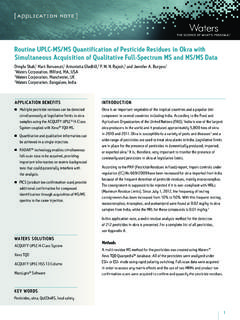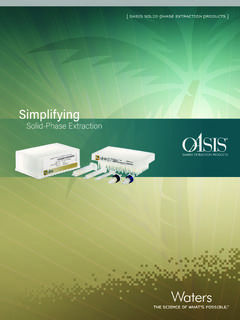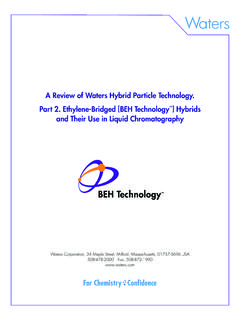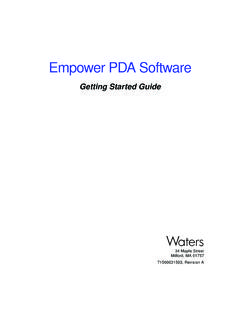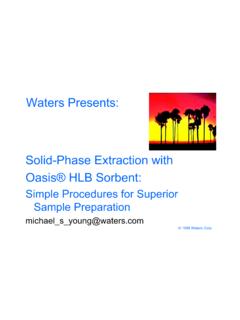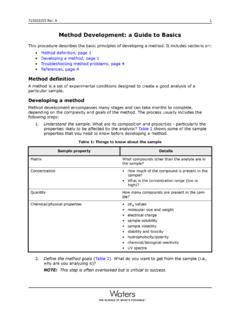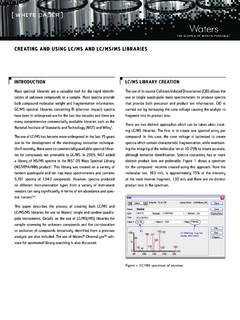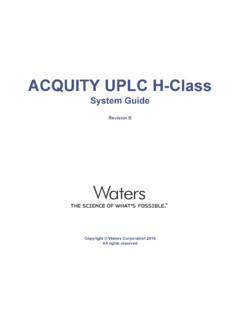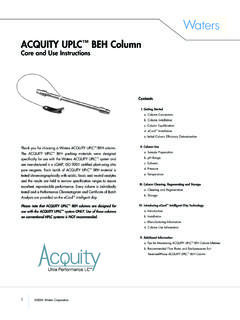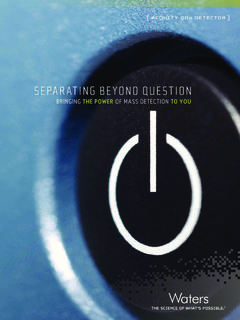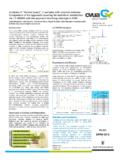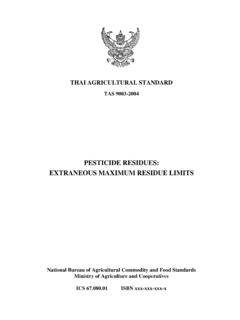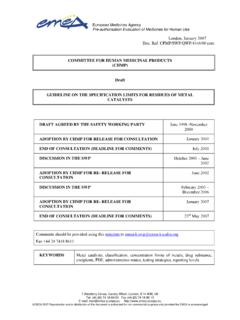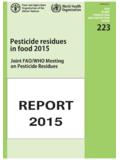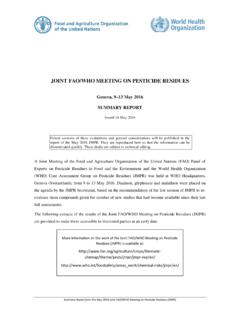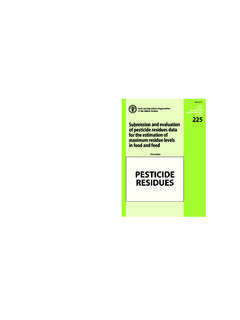Transcription of Comparison of SIM and MRM for the Quantitative ...
1 INTRODUCTIONThe inappropriate or unlawful use of pesticides on agricultural produce can result in unacceptably high levels of their residues in produce destined for human consumption. Food produce that is to be used for this purpose must contain less than the statutory maximum residue limit (MRL) of any given , there are over 800 compounds currently in use to control pests such as insects, weeds, rodents and fungi. The legal enforcement of regulations governing pesticide use requires the regular monitoring of foodstuffs. Given the large number of residues that may be found it is often advantageous to extract and determine as many of them as possible during a single analysis. An extraction, with acetonitrile, followed by dispersive solid phase extraction (SPE) clean up was reported for the analysis of a wide range of pesticides in fruits and vegetables1and fatty samples2.
2 As the number of target analytes is increased, the selectivity of the extraction method must be compromised, resulting in a more complex sample matrix. The potential for analytical interference from co-extracted substances is high and the analytical selectivity of such a method must be provided by the determinative spectrometry is a highly selective analyticaltechnique that can be used to monitor the masses ofspecific ions generated from the analytes of use of selected ion monitoring (SIM) provides a greater level of selectivity than other traditional detection methods, flame ionization detection (FID) or electron capture detection (ECD). However, when the analysis of multiresidue pesticides is required, in a variety of produce, the low selectivity of the clean-up stage means that even the use of SIM does not eliminate the potential for matrix reaction monitoring (MRM) is a tandemmass spectrometric technique that allows themonitoring of specific collision induced dissociation (CID) reactions.
3 The nature of CID reactions dependson molecular structure as well as mass and, as aresult, significant improvements in analyticalselectivity may be achieved using aim of this work was to compare the results from SIM and MRM using the Waters Micromass Quattro micro GC tandem quadrupole mass spectrometer for the quantification and confirmation of pesticide residues in simple through to complex food Hancock1, Jody Dunstan1, Carmen Wauschkuhn2, Diane Fuegel2and Michelangelo Anastassiades21 Waters Corporation, Manchester M22 5PP, Stuttgart, Fellnach 70736, OF SIM AND MRM FOR THE Quantitative CONFIRMATION OF PESTICIDE residues IN FOOD Waters Micromass Quattro micro GC Mass Method10 g frozen sample was weighed in a centrifuge tube. Acetonitrile (10 mL) was added along with 100 L of internal standard solution (PCB 138 and TPP) and the tube was shaken for 1 min.
4 MgSO4(4g) and NaCl (1g) were added and the solution buffered to pH with citrate buffer. After shaking and centrifugation, an aliquot was transferred to a vial containing PSA sorbent and anhydrous MgSO4. After undergoing further shaking and centrifugation, the extract was acidified to pH 5 to protect base-sensitive residues . The extract was analyzed by GC/MS and GC/ MethodAgilent 6890 GC with 7683 autosamplerColumnVarian FactorFour VF-5ms 30 m x mm , mFlow mL/min helium constant flowTemp. ramp40 C (Hold 2 min)220 C @ 30 C/min 260 C @ 5 C/min 280 C @ 20 C/min (Hold 15 min)Total run time32 min Injection method Cyro cooled PTV in solvent vent mode, 3 L injectedVent methodVent pressure 5 kPa, Vent flow 20 mL/min for minGC/MS/MS MethodThe Waters Micromass Quattro micro GC tandem quadrupole mass spectrometer was used in electron impact (EI+) mode.
5 The ion source was operated at 180 C with an electron energy of 70 eV and a trap current of 200 A. Two modes of acquisition were employed; SIM and MRM with an argon collision gas pressure of x Quattro micro GC was tuned so that the precursor and product ions were resolved with a peak width at half height of less than Da. The list of pesticide residues , the SIM masses and the MRM transitions, along with the collision energies for the method are listed in Table 1. The dwell, inter-channel and inter-scan times were unchanged between the and Processing MethodsThe data were acquired using Waters MassLynx Software and processed using the Waters TargetLynx Application SIM mode, three masses were acquired for each residue while in MRM mode it was two transitions. These were used so that quantification and confirmation could be performed with a single injection assuming that the ion ratio between the masses or transitions was consistent for standards and samples.
6 The confirmation criteria chosen was in accordance with the European Union (EU) guidance document Quality Control Procedures for Pesticide Residue Analysis (SANCO/10476/2003) AND DISCUSSIONFive food matrices were compared using SIM and MRM ranging from simple through to complex; cucumber, sweet pepper, grapefruit, wheat flour and curry powder. mg/kg was chosen to be the reporting level as this is half of the target MRL, for active substances in products for which no specific MRL is set, as specified in EU regulation (EC) NO 396/20054of 23 February both methods matrix-matched calibration curves were linear over the range mg/kg with correlation coefficients greater than for all analytes in all 1. SIM and MRM method (156)299 (255)117 (132)139 (107)96 (78)171 (276)245 (271)237 (208)104 (57)116 (131)125 (152)267 (188)127 (154)222 (221)96 (255)224 (208)213 (215)197 (169)168 (225)127 (99)180 (290)132 (162)212 (145)166 (96)181 (153)198 (183)176 (148)168 (167)169 (141)152 (102)233 (169)290 (290)MRM Product Ions13 (25)12 (15)20 (10)10 (10)8 (18)17 (7)10 (6)10 (25)8 (12)4 (10)14 (6)15 (25)25 (15)10 (15)10 (10)10 (13)22 (25)10 (10)5 (5)5 (10)5 (10)14 (6)5 (20)10 (12)6 (16)25 (25)10 (8)13 (13)10 (10)20 (30)12 (17)25 (25)MRM CE344 (344)372 (299)147 (147)251 (219)136 (136)333 (333)314 (314)272 (237)105 (172)206 (206)179 (179)337 (337)248 (248)223 (222)283 (283)225 (224)367 (369)199 (171)196 (267)173 (173)305 (305)206 (206)285 (212)238 (166)292 (292)199 (199)206 (176)169 (168)170 (169)
7 154 (154)326 (325)360 (362)MRM Precursor Ions344, 345, 388372, 374, 299147, 364, 366251, 253, 330136, 137, 226318, 333, 276314, 316, 187237, 272, 307172, 175, 305206, 131, 132179, 288, 245339, 337, 374248, 249, 154222, 223, 221283, 255, 285224, 225, 210367, 369, 371197, 199, 314267, 225, 196173, 158, 143276, 290, 305206, 220, 249212, 213, 215166, 238, 167292, 293, 277198, 199, 200206, 208, 176169, 168, 167170, 141, 169154, 153, 152326, 325360, 290 SIM , Int. 138, Int. difference in matrix interference from simple and complex foodstuffs is illustrated in Figure 1. In the case of pirimiphos-methyl from cucumber, there are few peaks from matrix interference whereas from curry powder there are many SIM mode, for our confirmation criteria to be passed, any concentrations in the extracts must have ion ratios of ( 30%) and ( 30%).
8 In this example, the ion ratios are and in cucumber, and and in curry powder which pass our confirmation criteria. For pirimiphos-methyl, quantification and confirmation by SIM is possible in both 1. mg/kg pirimiphos-methyl in cucumber and mg/kg in curry powder using Powder290276305290276305 Changing the mode of acquisition from SIM to MRM significantly increases the selectivity of the determinative step. Pirimiphos-methyl in curry powder with no matrix interference is illustrated in Figure 2. The lack of matrix interference peaks allows routine, automatic integration to be our confirmation criteria to be passed in MRM mode, any concentrations in the extracts must have an ion ratio of ( 30%). In this example, the ion ratio is in curry powder, which passes our confirmation criteria.
9 For pirimiphos-methyl, quantification and confirmation by MRM is possible in curry pesticide residues yield similar results. Biphenyl, vinclozolin and fludioxonil are illustrated in Figures 3, 4 and 5, respectively. Screening would be possible using SIM while confirmation is likely to be problematic if not impossible. However, moving to MRM significantly improves the selectivity in all cases, increasing the probability of being able to perform routine, automatic Powder305 290305 180 Figure 2. mg/kg pirimiphos-methyl in curry powder using 4. mg/kg vinclozolin in curry powder using SIM and 3. mg/kg biphenyl in curry powder using SIM and 152154 102 Figure 5. mg/kg fludioxonil in curry powder using SIM and 145285 213248154249248 127248 154 The results for all of the pesticide residues in all of the matrices are summarized in Table 2.
10 They show that both SIM and MRM can be used successfully for the screening of the majority residues . However, there are significant differences between the percentage of residues confirmed by MRM compared to SIM, particularly in the more complex 2. Percentage of residues successfully screened or confirmed in all five matrices using SIM or ion ratios are important as they provide the basis of confirmation. The ion ratio statistics presented in Table 3 are calculated for the 25 matrix injections across all five matrices. The low % RSDs indicate the good repeatability of the MRM PowderWheat FlourGrapefruitSweet RSDE trimfosPyrimethanilDichloranDiphenylamin eOPPB iphenylResidueTable 3. Ion ratio statistics for 25 matrix injections across five matrices using MRM method was also applied to real samples containing incurred pesticide different matrices were supplied to further test the method; orange, cherry tomato, grapes, kiwi and strawberry.
